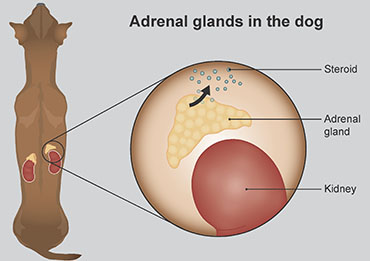Addison’s disease in dogs
Overview
- Addison’s disease is a condition that causes dangerously low levels of steroid hormones in the body.
- Steroid hormones are needed by almost every cell in the body, and are essential for life.
- Symptoms of Addison’s are often vague to begin with, but over time, tend to become more severe.
- Left untreated, Addison’s disease is often fatal, but fortunately, with treatment, most dogs have a good outlook and can live a relatively normal life.
- Addison’s disease can affect any dog, of any age, but is most common in middle-aged females.
What is Addison’s disease in dogs?
Addison’s disease (hypoadrenocorticism) is a condition that develops when the adrenal glands (see image below) stop producing two steroid hormones called cortisol and aldosterone.
Cortisol and aldosterone are essential for life, and without them, the body starts to fail.
In most cases, Addison’s is caused when the body’s own immune system mistakenly attacks the adrenal glands, which prevents them from working properly (this type of condition is called an ‘autoimmune’ or ‘immune mediated’ condition). Addison’s the opposite of Cushing’s disease (a condition that causes the adrenal glands to produce too much steroid).
Although Addison’s can affect any dog, it’s most common in middle aged (4-6 year old) females, and is seen most often in certain pedigree breeds such as the Standard poodle, West Highland White Terrier, Great Dane and St Bernard.

The adrenal glands sit in front of the kidneys and produce steroids. Click to enlarge.
Symptoms
To begin with, Addison’s often develops slowly, causing vague symptoms that come and go. Symptoms often include:
- Low energy (lethargy)
- Reduced appetite
- Weight loss
- Vomiting from time to time
- Diarrhoea from time to time
- Drinking and peeing more than usual
- Being weak and wobbly
- Just not being ‘quite right’
In some cases, Addison’s can develop rapidly and cause a life threatening condition known as an ‘Addisonian crisis’. Symptoms of an ‘Addisonian crisis’ include:
When to contact your vet
Addison’s disease can be tricky to spot because it often causes vague symptoms that come and go, however, it’s important to contact your vet if you notice any of the symptoms listed above, especially if they have been waxing and waning over time. Contact your vet urgently if your dog is showing symptoms of an ‘Addisonian crisis’ - this is an emergency.
Treatment
If your vet suspects your dog has Addison’s, it’s likely that they will need to run some tests to confirm, these are likely to include blood tests, urine tests, and possibly an ECG and an ultrasound scan. If your dog is diagnosed, they will need medication for the rest of their life, including:
- A monthly injection given by your vet (to replace aldosterone)
- Daily steroid tablets, given at home (to replace cortisol)
It’s important to follow your vet’s advice and give your dog all their medication as directed, because if their treatment is stopped, their symptoms will return. Watch our video for guidance on how to give your dog a tablet:
 Video found at youtu.be/A4v4f1_s-xQ
Video found at youtu.be/A4v4f1_s-xQ
Treating an Addisonian crisis - if your dog is having an Addisonian crisis, they will need emergency treatment including a fluid drip, steroids directly into their bloodstream and other medications to stabilise their condition. Once they are stable, treatment to control their Addison’s can begin.
Avoiding stress.
Steroid hormones help to keep the body healthy during times of stress, so a dog with Addison’s is at risk of becoming unwell if anything stressful occurs. To avoid problems it’s important to keep your dog as calm and relaxed as possible, and during times of unavoidable stress (such as Christmas, fireworks night, or a house move) your vet may advise a higher dose of medication. Never adjust your dog’s medication without speaking to your vet first.
Outlook
Most dog’s that respond well to treatment have a good outlook and can live a relatively normal life. Sadly, outlook is less positive if your dog doesn’t respond to treatment, has another condition that makes treatment complicated (such as diabetes), or has an ‘Addisonian crisis’ and doesn’t get treatment quickly.
Cost
Treatment for Addison’s can become very expensive because it’s a condition that requires lifelong treatment and regular check-ups. For this reason, it’s important to speak openly to your vet about your finances, the cost of treatment, as well as what you think is right for your dog. Consider insuring your dog as soon as you get them, before any signs of illness start. This will ensure you have all the support you need to care for them if they become unwell.
Published: January 2021
Did you find this page useful?
Tell us more
Please note, our vets and nurses are unable to respond to questions via this form. If you are concerned about your pet’s health, please contact your vet directly.
Thank you for your feedback
Want to hear more about PDSA and get pet care tips from our vet experts?
Sign up to our e-newsletter
Written by vets and vet nurses. This advice is for UK pets only. Illustrations by Samantha Elmhurst.

